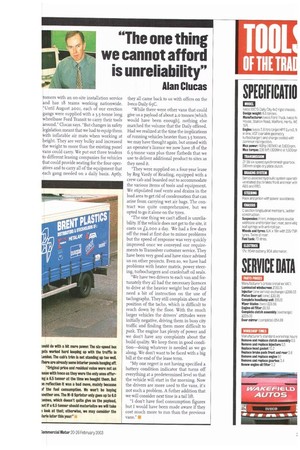INI
Page 27

Page 28

Page 29

If you've noticed an error in this article please click here to report it so we can fix it.
Iveco needs to go back to school with the Daily to master the three Rs: reliability, reliability and reliability; even so, this voluminous van has its merits...
The Daily range dates back to 1978 but, because of a marketing agreement with Ford, Iveco didn't sell the 2.8-3.5-tonne van models in the UK until the summer of 1999—the same time that the range was extended up to 6.5 tonnes. lveco's integral van range is subdivided into L and S classes while the heavier C (City Truck) class, at 3.5 tonnes and above, comes with a twin wheeled, riveted chassis that can be specified either as a van, chassis cab or with a crew cab.
Since the changes in dri ver licensing, there has been a polarisation at 3.5 tonnes and, at this weight, the Daily is Europe's best selling vehicle. The C class, with larger body options, has also seen growth and with the top weight raised from 6.o to 6.5 tonnes, the heaviest models are elevated into the light truck market where the vehicle competes alongside lveco's own 7.5-tonne Cargo Tector range. But there are significant differences between the two. Smaller wheels give the City Truck a lower load height, while the smaller, narrow van cab may give easier access for local delivery work. The smaller 2.8litre variably-turbocharged Unijet engine, also with common-rail injection and rated at 143hp, is more highly stressed and produces about a third less torque at a higher engine speed than with the 7.5-tonner's 3.9-litre power plant.
Van models offer load volumes up to 17.2m3 while the chassis cab caters for body lengths up to 6.2m with a payload that corn D petes with the 7.5-tormers. An un-truck-like front axle has independent suspension, which contributes to an excellent turning circle.
Similarly, hydraulic servo-assisted brakes emanate from light van origins, but the 6.5tormer benefits from discs all round and ABS (anti-lock braking system), ABD (automatic braking differential) and EBD (electronic brakeforce distribution) are all available.
Perhaps most importantly, while the payload is similar to its heavier stablemate, it is slightly lower priced.
CMs recent road test (CM 12-18 Sept 2002) D
tomers with an on-site installation service ilnd has 18 teams working nationwide. "Until August zooi, each of our erection gangs were supplied with a 3.5-tonne long wheelbase Ford Transit to carry their tools around," Clucas says. "But changes in safety legislation meant that we had to equip them With inflatable air mats when working at height. They are very bulky and increased the weight to more than the existing panel vans could carry. We put out three tenders to different leasing companies for vehicles that could provide seating for the four operatives and to carry all of the equipment that each gang needed on a daily basis. Aptly, they all came back to us with offers on the Iveco Daily 65C.
"While there were other vans that could give us a payload of about 2.o tonnes [which would have been enough], nothing else matched the volume that the Daily offered. Had we realized at the time the implications of running vehicles heavier than 3.5 tonnes, we may have thought again, but armed with an operator's licence we now have 18 of the 6.5-tonne vans plus three flatbeds that we use to deliver additional product to sites as they need it.
"They were supplied on a four-year lease by Reg Vardy of Reading, equipped with a crew cab and boarded out to accommodate the various items of tools and equipment. We stipulated roof vents and drains in the load area to get rid of condensation that can arise from carrying wet air bags. The contract was quite comprehensive, but we opted to go it alone on the tyres.
"The one thing we can't afford is unreliability. If the vehicle does not get to the site, it costs us £2,000 a day. We had a few days off the road at first due to minor problems but the speed of response was very quickly improved once we conveyed our requirements to Transolver customer service. They have been very good and have since advised us on other projects. Even so, we have had problems with heater matrix, power steering, turbochargers and crankshaft oil seals.
"We have two drivers to each van and fortunately they all had the necessary licences to drive at the heavier weight but they did need a bit of instruction on the use of tachographs. They still complain about the position of the tacho, which is difficult to reach down by the floor. With the much larger vehicles the drivers' attitudes were initially negative, driving them in busy city traffic and finding them more difficult to park. The engine has plenty of power and we don't have any complaints about the build quality. We keep them in good condition—doing whatever is needed as we go along. We don't want to be faced with a big bill at the end of the lease term.
"My one regret is not having specified a battery condition indicator that turns off everything at a predetermined level so that the vehicle will start in the morning. Now the drivers are more used to the vans, its not such a problem. A futher addition that we will consider next time is a tail lift.
"I don't have fuel consumption figures but I would have been made aware if they cost much more to run than the previous vans." •




























































































































































